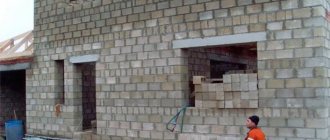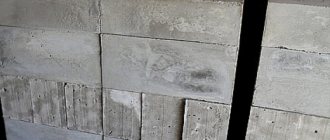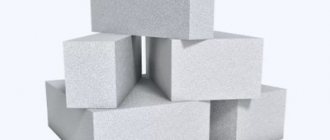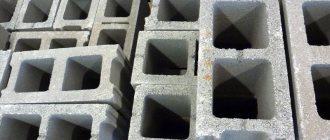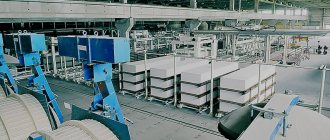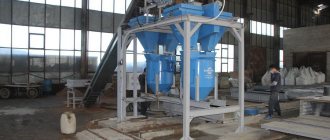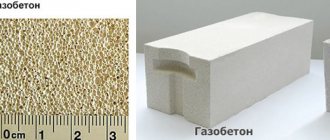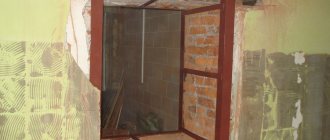You cannot start construction from the first materials you come across. Modernity and popularity do not play a role, since practical qualities are much more important. It is advisable to think about whether a cinder block or a foam block is better at the building design stage. After all, this decision will affect the main characteristics of the house: strength, environmental parameters, operational capabilities and service life. These materials are common in the construction market and are known to many. The products have similar qualities, but are fundamentally different from each other. Knowing the characteristics will help you avoid mistakes in construction, as well as financial waste.
Disadvantages of cinder blocks
- Simplicity and primitiveness of form and design. It is unlikely that this material will be suitable for the construction of any architectural masterpiece;
- Questionable environmental friendliness of the material. Some careless manufacturers change the composition of the blocks, so when purchasing, it is advisable to ask for a quality certificate for the product and compliance with GOST and SNIP;
- Cinder block must be subjected to external and internal cladding, as it does not tolerate moisture well. Moreover, it is not recommended to cover cinder blocks with plaster;
- Cinder block is suitable for private construction of buildings no more than 3 floors high;
What are the advantages of foam block?
The blocks made from lightweight cellular concrete differ from cinder blocks, possessing qualities that the latter lacks. Foam blocks have the following advantages:
- Increased waterproofing properties. Low absorbent properties appear even when the material is placed in water. A foam block in liquid does not sink. Therefore, no additional waterproofing is required.
- Excellent energy saving qualities. This figure is 3-4 times higher than that of a cinder block. Building a house from foam blocks allows you to significantly save on insulation and heating.
- Light weight and low load on the base. Like cinder block, foam block does not require the construction of an expensive foundation using special equipment.
- Ecological cleanliness. The environmental friendliness index of the foam block is approximately 99%, which allows us to compare this material with natural ones. Thanks to its porous structure, buildings made from it “breathe.”
The only point regarding the purchase of foam blocks is careful attention to the choice of supplier in order to exclude the purchase of counterfeit products of dubious quality.
Foam blocks, like aerated concrete, are made from cellular concrete.
Advantages of foam blocks
- The excellent thermal insulation of the material has been proven by builders. To achieve the same temperature in the room, you need to make brickwork 1.5 meters wide or better, 40 cm wide, made of foam concrete. The difference in thermal insulation qualities is obvious;
- Good sound insulation;
- The fire resistance of buildings made of foam concrete is as good as that of its related aerated concrete. During a scientific experiment, it was proven that walls built from foam concrete are capable of keeping a fire outside, preventing them from entering the room for 4 hours;
- The material is lightweight, like aerated concrete, which simplifies its delivery to the construction site and installation;
- The environmental friendliness of foam concrete, like aerated concrete, is slightly inferior to wood, but much better than that of brick and composite blocks;
- Foam concrete is easily processed both manually and using electrical devices. It is possible to use this material to create various architectural forms and design solutions.
What are the benefits of cinder block?
The use of construction waste has endowed cinder block with one significant advantage that contributes to its widespread use in the field of construction - low cost. There are no clear restrictions on the slag involved in the production process, which allows you to use almost any waste remaining on the construction site.
Cheapness is not the only advantage of the material. The advantages of cinder block include the following characteristics:
- fire and frost resistance, good thermal insulation;
- large sizes for easy transportation and stowage;
- possibility of production at home (garage) conditions;
- small specific gravity, practically independent of the dimensions of the block.
Cinder blocks are not affected by fungus or mold. They do not harbor bactericidal bacteria, pests and insects. They do not require the construction of complex foundations. This leads to a reduction in the cost of erecting one-story buildings and utility rooms.
Disadvantages of foam block
- It was stated above that foam concrete has good thermal insulation properties. However, these properties can only manifest themselves with proper laying with a minimum thickness of the binder material. It is usually better to use special glue for such purposes. But often, in order to save money, builders use cement mortars, which reduce the thermal insulation of the room to a minimum;
- All the simplicity in work lies only in laying the blocks. However, before construction begins, each block must be thoroughly cleaned, sanded, and polished. If the processing technique is violated, negative consequences may occur. In addition, unlike the high-tech production of aerated concrete, foam concrete is often made in artisanal conditions, which does not protect the buyer from low-quality goods;
- Installation of various types of fasteners is easy. However, they can just as easily get out. Therefore, hanging expensive equipment on a foam concrete wall, alas, is unsafe;
- The material, like aerated concrete, is light and therefore fragile. When building a house, it is better to seek advice from a specialist who will calculate the permissible weight of additional elements laid on the foam block.
Where is the best place to use it?
This review provides a complete description of the qualities of a foam block or cinder block. Each is used in the same field, has similar properties, but at the same time significant differences. It is important to know and understand in what case and what is best to use. For example, cinder block is considered a very good material for laying load-bearing walls. It is much cheaper than foam concrete, so it is used often. But it all depends on what the owner wants to get in the end. After all, cost is not the most important indicator.
Important! If thermal conductivity, strength, and heating savings are more attractive, then it is much better to build a residential building from foam blocks.
But when you need to build something small, you shouldn’t spend money on such expensive material. It's better to stick with cinder blocks. After all, in a garage or barn, sound insulation is not needed, and thermal conductivity is also not required. If you carry out high-quality waterproofing there, then there will be no problems with heating and dampness. You can create outbuildings from cinder blocks in a matter of days. The choice of material depends on the financial capabilities of the homeowner, the expected result, personal preferences and desires.
Foam block or cinder block test
Having analyzed the above qualities of both materials for the construction of low-rise buildings, we can conclude that foam block is better in some qualities. Foam concrete is larger in size, so transporting it will cost less. However, with larger dimensions, it has a lower specific gravity, and this makes direct work with it easier. It is better to use foam blocks during construction in areas with a changeable climate, since the blocks better insulate the room. However, in a debate about what to choose, no specialist will give you a definite answer.
Video
Cinder blocks and foam blocks are successfully used in the construction of buildings for various purposes. The widespread practice of using both materials does not negate the fact that the characteristics of these blocks are not known to everyone. If we draw a parallel between a brick and a wooden structure, then the future owner of the building will easily be able to make a choice in favor of one or another option, taking into account his own requirements and the purpose of the structure being built.
The situation is completely different when it comes to blocks. The similarity of shape gives many people the erroneous impression that these two materials are practically identical. And to answer the question as to which is better: a cinder block or a foam block, it is necessary to consider the characteristics of each. If you know all the pros and cons of these blocks, conduct a comparative analysis, and make a choice in favor of one option or another, it will not be difficult.
Gas block
The main parameter is high porosity . It is determined by the manufacturing method. A gasifying agent, usually aluminum powder, is added to a mixture of . In this case, a chemical reaction occurs, as a result of which hydrogen is released. The gas cannot leave the mass of concrete and forms many small bubbles that evenly fill the entire volume of the material. This texture determines all the qualities of cellular concrete.
There are autoclaved and non-autoclaved aerated concrete . The first is distinguished by higher hardness and strength with the same porosity and absolute accuracy of size and shape. After swelling, the material is cut into blocks and then steamed in an autoclave at +200°C and 12 atm. Non-autoclave after expansion is poured into molds in which the material dries naturally. This option is less durable, less homogeneous, retains its shape worse, but it is cheaper and absorbs moisture less: the pores in the foam block are closed. They usually compare autoclave material and cinder block.
Cinder blocks can be made at home if necessary. Autoclaved aerated concrete is produced only in production.
Foam concrete, aerated concrete, polystyrene concrete, expanded clay concrete, brick - which is better?
Due to their light weight, low price and good technical parameters, foam blocks are loved by developers.
What will be the results if we compare foam concrete with other building materials suitable for the same purposes? Let's find out, and first compare cinder block, aerated concrete, foam concrete, gas silicate (gas silicate blocks), expanded clay concrete, polystyrene concrete and answer: which is better, what are the differences and similarities between the materials?
Reviews
- Alexander: “When building the garage, I used mainly foam blocks, since there are doubts about the quality of cinder block materials. The outside still has to be insulated, if only for reasons of aesthetics of the building. In terms of cost, of course, it hit the pocket a little, but the garage was designed for more than one year of use. In general, my sympathies are exclusively on the side of foam blocks.”
- Vladimir: “I used both materials in the construction of the country house. The calculations were made by an experienced builder, so there is no doubt. For especially important and load-bearing structures, cinder block was used, since it is much stronger and heavier. Foam block was also used, but for the veranda and intermediate walls. It turned out well, we haven’t tested it with time yet (the construction was recently completed), but I hope everything will be fine. I plan to live in the house permanently in the summer and periodically heat it on weekends. It seems like everything should be fine, but winter will tell.”
You may also be wondering what is the difference between aerated block and foam block. Also read which is better: foam block or gas block. The pros and cons of gas blocks are described here, and the properties of gas blocks are described here.
How much does a foam block cost per piece?
Prices for foam blocks
| FOAM BLOCK SIZES | Quantity per 1m³ pcs | PRICE per piece |
| D600 15-30-60 cm (150-300-600 mm) | 37,04 | RUB 118.80 |
| D600 20-30-60 cm (200-300-600 mm) | 27,78 | RUB 158.40 |
| D600 40-20-60 cm (400-200-600 mm) | 20,83 | RUR 213.60 |
| D600 25-30-60 cm (250-300-600 mm) | 22,22 | RUB 198.00 |
Interesting materials:
What tiles should I put in the entrance? How much area does the oil radiator heat? What kind of soil does Kalina Buldenezh like? What kind of soil does oleander like? What kind of substrate can be laid under linoleum? What mesh should I use to putty the walls? What putty should I use to seal joints in drywall? What plaster mixture is used for smooth concrete surfaces? What lubricant should I use for the hammer drill gearbox? What hot water temperature should I set on the boiler?
Foam block and cinder block - comparison
Aerated concrete has recently become popular in construction; cinder blocks have been used by builders for a long time to construct objects. The popularity of aerated concrete was influenced by its low cost, global crisis, and availability for any developer.
Cinder blocks began to be used en masse from 1927 to 1930. This was the time of industrialization in the country. When they began to smelt steel and cast iron in large quantities. The resulting slag was considered waste material and had to be used.
Even today, we sometimes see old buildings built using cinder blocks (see Cinder block masonry: features and technology). In those days, the material was attracted by its low cost and ease of manufacture. This was important! The country was rising!
What are the benefits of a block structure? After all, it has its own advantages and disadvantages, they must be studied before making a decision.
- First of all, this is the speed of construction , because the blocks are larger than bricks and the work can be done quite quickly.
- So does thermal insulation. There are of course some differences here, but overall it’s excellent.
- By doing the work yourself, you can significantly reduce costs. After all, face masonry is not done here.
Attention: The main disadvantage of the blocks is the mandatory cladding. It's just not a face material. And therefore, when deciding whether cinder blocks or foam blocks are better, you should immediately include the cost of finishing.
Foam blocks or cinder blocks, which is better depends on the parameters of the material. The characteristics that are important here are, first of all, they are different. Let’s go straight to them and look at cinder blocks or foam blocks, which is better in terms of their performance.
Manufacturing of gas blocks
A new technology is used for production - foaming.
- It consists of cement, sand and water. The composition is foamed and poured into molds, where the products harden. Become suitable for construction. The internal component is a large number of microscopic air bubbles. They give the product lightness.
- Therefore, the products do not allow moisture to pass through easily and do not sink in water. They have enhanced waterproofing. The blocks do not require additional protection - this is a positive quality that is highly valued by developers. For them, this is a profitable material!
- It almost does not allow heat to pass through, which indicates energy saving. As a result, in winter you can save on heating costs. Building an object from blocks is a pleasure and an attraction for any developers. Walls are built from it quickly. Organizers do not need to carry heavy products. The walls can be laid out in one row, the house will still be warm. There is no need to involve a lot of people to carry out the construction process. The construction option is one of the most profitable and has become available to many since the invention of the product.
- Due to the lightness of the material, there is no need to build a complex foundation. Even a lightweight foundation will do, because the weight of the building will still be light. Work on its installation is carried out without the use of specialized equipment. The result is a reduction in costs for the facility, a benefit for the developer.
If the blocks are not counterfeit, then their index reaches 99%. Therefore, it is sometimes compared to a tree. The porous structure of the blocks allows the building to breathe.
As it happens in a wooden house. Therefore, the buildings have a good microclimate.
They are easy to cut, creating objects of unusual shape during construction. The design solution for the facility can be anything, taking into account the customer’s requirements.
The advantages of the material also include:
- Excellent thermal insulation, due to which objects do not need to be insulated additionally;
- The speed of creation of structures, this is due to the low weight of the products;
- The porosity of aerated concrete gives the products vapor permeability;
- The ability to build external walls in one layer, even without insulation;
- No harm to humans or animals.
Cinder blocks - production
Cinder block has been popular since ancient times. Cheap product for the construction of objects.
- Reduced level of sound insulation;
- Upon completion of the construction of the facility, finishing of external structures with brick is required. Which increases costs.
- It is difficult to lay utility networks for a facility through walls and partitions;
- Cinder block is afraid of water, due to which the service life of objects is reduced;
- A cinder block structure needs waterproofing after construction, and construction costs increase.
Basic properties of cinder block and gas block
Comparison of technical characteristics:
| Characteristic | Aerated concrete | cinder block |
| Strength class, B | 3.5…10 | 3.5…30 |
| Compressive strength, kg/cm² | 32…46 | 35…200 |
| Density, kg/m³ | 400…1100 | 750…1450 |
| Thermal conductivity, W/(m*S) | 0.45…0.55 | 0.27…0.65 |
| Frost resistance, cycles | 15…100 | 15…50 |
| Moisture absorption,% by weight | up to 20 | until 9 |
| Noise insulation, dB | 50 | 43 |
Differences and similarities of materials
The main difference between slag concrete and aerated concrete blocks is higher strength, density, and low water absorption. These properties make it possible to use the slag block for the construction of not only load-bearing walls and interior partitions, but also foundations. In terms of thermal conductivity and sound insulation, cinder block is slightly inferior to aerated concrete. Both materials belong to the NG-non-flammable class, do not support combustion, and prevent the spread of open fire. By the way, foam concrete blocks and other cellular wall materials have the same properties.
Separately, it is necessary to say about environmental friendliness. It is believed that aerated block is a more environmentally friendly material, since it contains only natural components, including a mineral-based gas-forming agent. This is absolutely true! But cinder block cannot be classified as a “harmful” material. Its composition includes environmentally friendly slag from metallurgical waste, but its environmental friendliness is still lower than that of a gas block.
Advantages and disadvantages
Each type of block has its own pros and cons, which are recommended to be carefully studied when choosing what is best to build a house from.
- variety of sizes and shapes;
- high strength;
- low water absorption;
- suitable for foundation construction;
- require cladding due to low aesthetics;
- questionable environmental friendliness;
- low accuracy of block geometry.
- environmental friendliness;
- exact geometric dimensions;
- ease of installation;
- excellent noise and heat insulation.
- high moisture absorption capacity;
- not suitable for foundation;
- requires lining due to high water absorption.
Both materials require a finish that will reliably protect them from moisture. In this parameter, gas block and cinder block are inferior to ceramic brick. But in terms of speed of construction and ease of erecting a “box”, blocks are in many ways superior to bricks.
Brief overview of the main characteristics of materials, pros and cons
Brick, cinder blocks, foam concrete, wood concrete or aerated concrete are materials for the construction of walls, foundations and ceilings. How to make the right choice?
Brick . The dimensions of a standard brick are 250×120×65 mm. Made from environmentally friendly components. Durable and frost-resistant material. Density - up to 2000 kg/m?. Tensile strength - from 15 MPa.
Cinder block . Dimensions of standard blocks are 390x190x188 mm. It has voids, due to which the weight of the material is reduced. The density of cinder block is from 750 to 1455 kg/m?. Weight ranges from 10 to 28 kg. Foam concrete and aerated concrete . They belong to the class of cellular concrete. The sizes of the blocks are presented in a huge assortment. The density reaches 1200 kg/m2, and the tensile strength depends on the brand of blocks.
Arbolit . The most common sizes are 500x300x200 mm. The main component of wood concrete is wood chips. The density of the blocks varies from 550 to 700 kg/m2. The weight of one wood concrete reaches 18 kg.
What's better
No one can give a knowingly correct answer. If we look at the issue from several angles, foam blocks have more advantages in using them. However, the popularity of the second material is also beyond doubt. If we consider what is cheaper, then the cost of finished cinder blocks is an order of magnitude less, which often becomes a priority when choosing a suitable material.
Having compared the technical characteristics, it is also impossible to come to an unambiguous conclusion; some heat losses inherent in cinder block material also apply to foam blocks to one degree or another, so it would not hurt to perform external insulation for this material as well.
To summarize, we can say with confidence that for the construction of residential buildings it is preferable to use foam blocks due to the low thermal conductivity of the material. It is better to use cinder block for the construction of utility and industrial facilities, for which this indicator will not be so important. The option of using a combined composition of materials is allowed: to lay the foundation and basement floor, use cinder block as a cheaper and stronger material, and use foam blocks when constructing walls.
The video explains which is better: foam block or cinder block:
The most important task after deciding to build a house is the choice of building materials. And you need to choose whether a foam block or a cinder block is better at the stage when the house is still under construction. This decision will determine the characteristics of the finished structure, environmental parameters and operational life. Both materials have been on the construction market for quite a long time and are quite widely known. They are similar in some ways, but they also have a lot of differences. You need to consider the main characteristics and make a comparison: which is cheaper and better?

